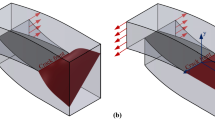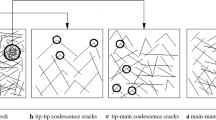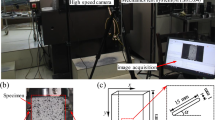Abstract
To obtain the stress intensity factors (SIFs) of transversely isotropic central cracked Brazilian disk (CCBD), an anisotropy coefficient f is introduced based on the isotropic analytical formula. The coefficient f is related to the anisotropy orientation β, the anisotropy ratio of Young’s modulus ξ, and the apparent shear modulus η. The comprehensive calibration of f is accomplished by the finite element method. Then the formulae for mode I and II SIFs are obtained by fitting f to the analytical solutions of the isotropic CCBD, which realizes the generalization and application of the formulae in transversely isotropic rocks based on the isotropic condition. The new formulae presented in this paper can calculate the SIFs for any given elastic modulus, crack length, anisotropy orientation and certain loading angle range (0°–25°). The results show that the relative errors between the formula and the numerical simulation results are within 5%, and the relative errors with other researches are within 2.8%. Both the SIFs and the correlation coefficients M1(β), M2(β), and N1(β) show a variation of sine or cosine concerning the anisotropy orientation β. And the influence of ξ and η on SIFs can be negligible by adjusting β to some specific angles given in this paper.









Similar content being viewed by others
REFERENCES
N. Dutler, M. Nejati, B. Valley, Et Al., “on The Link Between Fracture Toughness, Tensile Strength, And Fracture Process Zone In Anisotropic Rocks,” Eng. Fract. Mech. 201, 56–79 (2018). https://doi.org/10.1016/j.engfracmech.2018.08.017
N.v. Cherdantsev, “approach To Constructing A Hydraulic Fracture Trajectory In A Rock Mass Near A Mine Working,” Mech. Solids 55, 1372–1391 (2020). https://doi.org/10.3103/s0025654420080063
N.v. Cherdantsev And S.v. Cherdantsev, “analysis Of The State For A Coal Massif Enclosing In-seam Working And A Geological Discontinuity,” Mech. Solids 53, 211–220 (2018). https://doi.org/10.3103/s0025654418020127
G.r.irwin, “analysis Of Stresses And Strains Near The End Of A Crack Traversing A Plate,” Appl. Mech. 361–364 (1957). https://doi.org/10.1115/1.4011547
C.s. Chen, E. Pan And B. Amadei, “determination Of Deformability And Tensile Strength Of Anisotropic Rock Using Brazilian Tests,” Int. J. Rock. Mech. Min. 35, 43–61 (1998). https://doi.org/10.1016/s0148-9062(97)00329-x
Y.-c. Chou And C.-s. Chen, “determining Elastic Constants Of Transversely Isotropic Rocks Using Brazilian Test And Iterative Procedure,” Int. J. Numer. Anal. Methods Geomech. 32, 219–234 (2008). https://doi.org/10.1002/nag.619
L. Federici, A. Piva, And E. Viola, “crack Edge Displacement And Elastic Constant Determination For An Orthotropic Material,” Theor. Appl. Fract. Mech. 31, 173–187 (1999). https://doi.org/10.1016/s0167-8442(99)00012-9
A. Aminzadeh, A. Fahimifar, And M. Nejati, “on Brazilian Disk Test For Mixed-modei/iifracture Toughness Experiments Of Anisotropic Rocks,” Theor. Appl. Fract. Mech. 102, 222–238 (2019). https://doi.org/10.1016/j.tafmec.2019.04.010
M. Nejati, A. Aminzadeh, M.o. Saar, Et Al., “modified Semi-circular Bend Test To Determine The Fracture Toughness Of Anisotropic Rocks,” Eng. Fract. Mech. 213, 153–171 (2019). https://doi.org/10.1016/j.engfracmech.2019.03.008
M. Nejati, A. Aminzadeh, F. Amann, Et Al., T. Driesner, “mode I Fracture Growth In Anisotropic Rocks: Theory And Experiment,” Int. J. Solids Struct. 195, 74–90 (2020). https://doi.org/10.1016/j.ijsolstr.2020.03.004
M. Nejati, A. Aminzadeh, T. Driesner, Et Al., “on The Directional Dependency Of Mode I Fracture Toughness In Anisotropic Rocks,” Theor. Appl. Fract. Mech. 107, (2020). https://doi.org/10.1016/j.tafmec.2020.102494
M. Nejati, B. Bahrami, M.r. Ayatollahi, Et Al., “on The Anisotropy Of Shear Fracture Toughness In Rocks,” Theor. Appl. Fract. Mech. 113, (2021). https://doi.org/10.1016/j.tafmec.2021.102946
M. Nejati, S. Ghouli, And M.r. Ayatollahi, “crack Tip Asymptotic Fields In Anisotropic Planes: Importance Of Higher Order Terms,” Appl. Math. Model. 91, 837-862 (2021). https://doi.org/10.1016/j.apm.2020.09.025
M.h.b. Nasseri, G. Grasselli, And B. Mohanty, “fracture Toughness And Fracture Roughness In Anisotropic Granitic Rocks,” Rock. Mech. Rock. Eng. 43, 403–415 (2009). https://doi.org/10.1007/s00603-009-0071-z
M.r. Chandler, P.g. Meredith, N. Brantut, Et Al., “fracture Toughness Anisotropy In Shale,” J. Geophys. Res.: Solid Earth. 121, 1706–1729 (2016). https://doi.org/10.1002/2015jb012756
C.c. Ke, C.s. Chen, And C.h. Tu, “determination Of Fracture Toughness Of Anisotropic Rocks By Boundary Element Method,” Rock. Mech. Rock. Eng. 41, 509–538 (2006). https://doi.org/10.1007/s00603-005-0089-9
M.c. Baik, S.h. Choi, J.s. Hawong, Et Al., “determination Of Stress-intensity Factors By The Method Of Caustics In Anisotropic Materials,” Exp. Mech. 35, 137–143 (1995). https://doi.org/10.1007/bf02326471
O. Demir, “analytical Investigation On Prediction Of Fatigue Crack Growth Lives Of Cracked Nonhomogeneous Materials,” J Mech. Mater. Struct. 16, 429–440 (2021). https://doi.org/10.2140/jomms.2021.16.429
M. Nagai, T. Ikeda, And N. Miyazaki, “stress Intensity Factor Analysis Of A Three-dimensional Interface Crack Between Dissimilar Anisotropic Materials,” Eng. Fract. Mech. 74, 2481–2497 (2007). https://doi.org/10.1016/j.engfracmech.2006.12.027
J.f. Dwyer And E. Pan, “edge Function Analysis Of Stress Intensity Factors In Cracked Anisotropic Plates,” Int. J. Fract. 72, 327–342 (1995). https://doi.org/10.1007/bf00040371
C.s. Chen, E. Pan, And B. Amadei, “fracture Mechanics Analysis Of Cracked Discs Of Anisotropic Rock Using The Boundary Element Method,” Int. J. Rock. Mech. Min. 35, 195–218 (1998). https://doi.org/10.1016/s0148-9062(97)00330-6
J.h. Kim And G.h. Paulino, “mixed-mode Fracture Of Orthotropic Functionally Graded Materials Using Finite Elements And The Modified Crack Closure Method,” Eng. Fract. Mech. 69, 1557–1586 (2002). https://doi.org/10.1016/s0013-7944(02)00057-7
J.h. Kim And G.h. Paulino, “mixed-mode J-integral Formulation And Implementation Using Graded Elements For Fracture Analysis Of Nonhomogeneous Orthotropic Materials,” Mech. Mater. 35, 107–128 (2003). https://doi.org/10.1016/s0167-6636(02)00159-x
A. De Klerk, A.g. Visser, And A.a. Groenwold, “lower And Upper Bound Estimation Of Isotropic And Orthotropic Fracture Mechanics Problems Using Elements With Rotational Degrees Of Freedom,” Commun. Numer. Meth. En. 24, 335–353 (2008). https://doi.org/10.1002/cnm.973
L. Banks-sills, I. Hershkovitz, P.a. Wawrzynek, Et Al., “methods For Calculating Stress Intensity Factors In Anisotropic Materials: Part I—z=0 Is A Symmetric Plane,” Eng. Fract. Mech. 72, 2328–2358 (2005). https://doi.org/10.1016/j.engfracmech.2004.12.007
L. Banks-sills, P.a. Wawrzynek, B. Carter, Et Al., “methods For Calculating Stress Intensity Factors In Anisotropic Materials: Part Ii—arbitrary Geometry,” Eng. Fract. Mech. 74, 1293–1307 (2007). https://doi.org/10.1016/j.engfracmech.2006.07.005
G. Dhondt, “mixed-mode K-calculations In Anisotropic Materials,” Eng. Fract. Mech. 69, 909–922 (2002). https://doi.org/10.1016/s0013-7944(01)00127-8
W. Xu, C. Zhang, X.r. Wu, Et Al., “weight Function Method And Its Application For Orthotropic Single Edge Notched Specimens,” Compos. Struct. 252, (2020). https://doi.org/10.1016/j.compstruct.2020.112695
Q.-d. Zeng, J. Yao, And J. Shao, “numerical Study Of Hydraulic Fracture Propagation Accounting For Rock Anisotropy,” J. Pet. Sci. Eng. 160, 422–432 (2018). https://doi.org/10.1016/j.petrol.2017.10.037
E. Mohtarami, A. Baghbanan, H. Hashemolhosseini, Et Al., “fracture Mechanism Simulation Of Inhomogeneous Anisotropic Rocks By Extended Finite Element Method,” Theor. Appl. Fract. Mech. 104, (2019). https://doi.org/10.1016/j.tafmec.2019.102359
H. Zarrinzadeh, M.z. Kabir, And A. Varvani-farahani, “static And Dynamic Fracture Analysis Of 3d Cracked Orthotropic Shells Using Xfem Method,” Theor. Appl. Fract. Mech. 108, (2020). https://doi.org/10.1016/j.tafmec.2020.102648
M.r. Ayatollahi, M. Nejati, And S. Ghouli, “crack Tip Fields In Anisotropic Planes: A Review,” Int. J. Fract. (2021). https://doi.org/10.1007/s10704-021-00559-2
R. Cappello, G. Pitarresi, J. Xavier, Et Al., “experimental Determination Of Mode I Fracture Parameters In Orthotropic Materials By Means Of Digital Image Correlation,” Theor. Appl. Fract. Mech. 108, (2020). https://doi.org/10.1016/j.tafmec.2020.102663
S.k. Khanna And A. Shukla, “development Of Stress-field Equations And Determination Of Stress Intensity Factor During Dynamic Fracture Of Orthotropic Composite-materials,” Eng. Fract. Mech. 47, 345–359 (1994). https://doi.org/10.1016/0013-7944(94)90092-2
S. Samarasinghe And D. Kulasiri, “stress Intensity Factor Of Wood From Crack-tip Displacement Fields Obtained From Digital Image Processing,” Silva. Fenn. 38, 267–278 (2004).
A. Shukla, B.d. Agarwal, And B. Bhushan, “determination Of Stress Intensity Factor In Orthotropic Composite-materials Using Strain-gauges,” Eng. Fract. Mech. 32, 469–477 (1989). https://doi.org/10.1016/0013-7944(89)90318-4
D. Chakraborty, K.s.r.k. Murthy, And D. Chakraborty, “a New Single Strain Gage Technique For The Accurate Determination Of Mode I Stress Intensity Factor In Orthotropic Composite Materials,” Eng. Fract. Mech. – , 142–154 (2014). https://doi.org/10.1016/j.engfracmech.2014.04.011
D. Chakraborty, D. Chakraborty, And K.s.r.k. Murthy, “a Strain Gage Technique For The Determination Of Mixed Mode Stress Intensity Factors Of Orthotropic Materials,” Compos. Struct. 160, 185–194 (2017). https://doi.org/10.1016/j.compstruct.2016.10.044
D. Chakraborty, K.s.r.k. Murthy, And D. Chakraborty, “experimental Determination Of Mode I Stress Intensity Factor In Orthotropic Materials Using A Single Strain Gage,” Eng. Fract. Mech. 173, 130–145 (2017). https://doi.org/10.1016/j.engfracmech.2017.01.002
Y. Mikami, M. Kurashige, And K. Imai, “mechanical Response Of A Water-saturated Core Sample Under Opposite Diametrical Loadings,” Acta. Mech. 158, 15–32 (2002). https://doi.org/10.1007/bf01463166
S.k. Kourkoulis, C.f. Markides, And J.a. Hemsley, “frictional Stresses At The Disc-jaw Interface During The Standardized Execution Of The Brazilian Disc Test,” Acta Mechanica, 224, 255–268 (2013). https://doi.org/10.1007/s00707-012-0756-3
S. Dong, Y. Wang, And Y. **a, “stress Intensity Factors For Central Cracked Circular Disk Subjected To Compression,” Eng. Fract. Mech. 71, 1135–1148 (2004). https://doi.org/10.1016/s0013-7944(03)00120-6
B. Hf, “a Novel Principle For The Computation Of Stress Intensity Factors,” Z. Angew. Math. Mech. 529–546 (1970).
J.r. Rice, “some Remarks On Elastic Crack-tip Stress Fields,” Int. J. Solids Struct. 8, 751–758 (1972). https://doi.org/10.1016/0020-7683(72)90040-6
T. Fett, “stress Intensity Factors And T-stress For Internally Cracked Circular Disks Under Various Boundary Conditions,” Eng. Fract. Mech. 68, 1119–1136 (2001). https://doi.org/10.1016/s0013-7944(01)00025-x
G.c. Sih, P.c. Paris And G.r. Irwin, “on Cracks In Rectilinearly Anisotropic Bodies,” Int. J. Fract. Mech. 1, 189–203 (1965). https://doi.org/10.1007/bf00186854
T.c.t. Ting, Anisotropic Elasticity: Theory And Applications, (Oxford Uni. Press, New York, 1996).
J. Claesson And B. Bohloli, “brazilian Test: Stress Field And Tensile Strength Of Anisotropic Rocks Using An Analytical Solution,” Int. J. Rock. Mech. Min. 39, 991–1004 (2002). https://doi.org/10.1016/s1365-1609(02)00099-0
S. Dong, “theoretical Analysis Of The Effects Of Relative Crack Length And Loading Angle On The Experimental Results For Cracked Brazilian Disk Testing,” Eng. Fract. Mech. 75, 2575–2581 (2008).
G.e. Exadaktylos, “on The Constraints And Relations Of Elastic Constants Of Transversely Isotropic Geomaterials,” Int. J. Rock. Mech. Min. 38, 941–956 (2001). https://doi.org/10.1016/j.engfracmech.2007.09.008
Z. Gan, X. Pan, H. Tang, Et Al., “experimental Investigation On Mixed Mode I-iii Fracture Characteristics Of Sandstone Corroded By Periodic Acid Solution,” Theor. Appl. Fract. Mech. 114, (2021). https://doi.org/10.1016/j.tafmec.2021.103034
M. Nejati, A. Paluszny, And R.w. Zimmerman, “on The Use Of Quarter-point Tetrahedral Finite Elements In Linear Elastic Fracture Mechanics,” Eng. Fract. Mech. 144, 194–221 (2015). https://doi.org/10.1016/j.engfracmech.2015.06.055
X. Pan, J. Huang, Z. Gan, Et Al., “investigation On Mixed-mode Ii-iii Fracture Of The Sandstone By Using Eccentric Cracked Disk,” Theor. Appl. Fract. Mech. 115, (2021). https://doi.org/10.1016/j.tafmec.2021.103077
X. Pan, J. Huang, Z. Gan, Et Al., “analysis Of Mixed-mode I/ii/iii Fracture Toughness Based On A Three-point Bending Sandstone Specimen With An Inclined Crack,” Appl. Sci-basel. 11, (2021). https://doi.org/10.3390/app11041652
J. Huang, J. Li, X. Pan, Et Al., “numerical Investigation On Mixed Mode (I-ii) Fracture Propagation Of Ccbd Specimens Under Confining Pressure,” Int. J. Appl. Mech. 12, (2020). https://doi.org/10.1142/s1758825120501112
Funding
This work was supported by the National Natural Science Foundation of China (nos. 11872042 and 12132019), and China Postdoctoral Science Foundation (2019M653395).
Author information
Authors and Affiliations
Corresponding author
Appendices
Nomenclature
a | Half crack length |
B | Disk thickness |
E, E ' | Young’s moduli within and normal to the isotropy plane |
f | Anisotropy coefficient defined as the ratio of anisotropic SIFs to isotropic SIFs |
FI, FII | Normalized stress intensity factors |
G, G ' | Shear moduli within and normal to the plane of isotropy |
\(G_{{{\text{SV}}}}^{'}\) | Transverse shear modulus approximated from the Saint-Venant relation |
h1(x, a), h2(x, a) | Weight function |
k c | The correction factor under different relative crack lengths and anisotropy orientation |
KI, KIC | Mode I stress intensity factor and fracture toughness |
KII, KIIC | Mode II stress intensity factor and fracture toughness |
P | Concentrated force |
r, θ | Polar coordinate located at the center of uncracked disk |
R | Disk radius |
x, y | Oriented along with the horizontal and vertical directions |
x ', y ' | Parallel to and normal to the transverse isotropic plane |
α | Relative crack length |
β | The angle between the transversely isotropic plane and the horizontal plane |
γ | The influence coefficient, ∆FII/∆ξ |
η | Anisotropy ratio of apparent shear modulus, G'/\(G_{{{\text{SV}}}}^{'}\) |
ξ | Anisotropy ratio of Young’s modulus, E/E' |
τθ, τrθ | Normal and tangential stress distribution for uncracked disk |
υ, υ ' | Poisson’s ratio within and normal to the plane of isotropy |
Abbreviations | |
BEM | Boundary element method |
CCBD | Central cracked Brazilian disk |
COD | Crack opening displacement |
FEM | Finite element method |
ISRM | International Society for Rock Mechanics |
QPES | Quarter point element stress |
SCB | Semi-circular bend |
SIF | Stress intensity factor |
XFEM | Extended finite element method |
APPENDIX A.
About this article
Cite this article
Huang, L., Tang, H.Z., Gan, Z.Q. et al. Numerical Calibration of Stress Intensity Factor for Transversely Isotropic Central Cracked Brazilian Disk. Mech. Solids 57, 835–855 (2022). https://doi.org/10.3103/S0025654422040082
Received:
Revised:
Accepted:
Published:
Issue Date:
DOI: https://doi.org/10.3103/S0025654422040082




